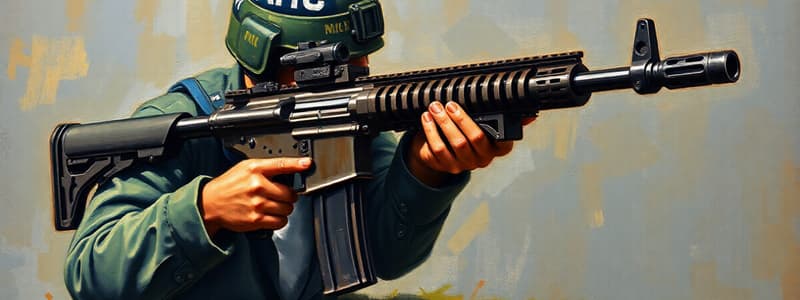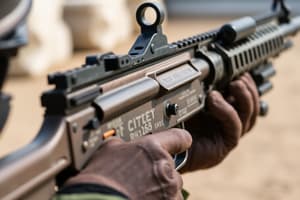Podcast
Questions and Answers
A unit is consolidating after an assault and is vulnerable to a counterattack. Which type of fire support is MOST appropriate in this scenario?
A unit is consolidating after an assault and is vulnerable to a counterattack. Which type of fire support is MOST appropriate in this scenario?
- Fires in support of consolidation to protect against counterattacks. (correct)
- Long range fires to disrupt enemy movements far from the consolidated position.
- Fires in support of isolation to prevent enemy reinforcements.
- Fires in support of the assault to eliminate remaining pockets of resistance.
A gunner needs to engage a moving enemy vehicle that requires significant adjustments in direction but minimal vertical movement. What type of fire technique is MOST suitable?
A gunner needs to engage a moving enemy vehicle that requires significant adjustments in direction but minimal vertical movement. What type of fire technique is MOST suitable?
- Fixed fire, as it requires minimal adjustments.
- Swinging traverse, as it allows for significant horizontal adjustments. (correct)
- Enfilade fire, as it aligns with the target's long axis.
- Grazing fire, as it stays close to the ground.
Which statement BEST describes the concept of enfilade fire?
Which statement BEST describes the concept of enfilade fire?
- Fire where the beaten zone aligns with the long axis of the target. (correct)
- Fire delivered against the side of an enemy formation.
- Fire that does not rise more than 1 meter above the ground.
- Fire used to isolate the enemy from reinforcements.
A unit is establishing a final protective line (FPL). Under what conditions can fires be initiated along this line?
A unit is establishing a final protective line (FPL). Under what conditions can fires be initiated along this line?
Based on the provided data, which weapon system has the longest maximum effective range?
Based on the provided data, which weapon system has the longest maximum effective range?
A squad automatic weapon (SAW) team is positioned to provide flanking fire. Under what circumstances would the section leader order them to displace to a new fighting position?
A squad automatic weapon (SAW) team is positioned to provide flanking fire. Under what circumstances would the section leader order them to displace to a new fighting position?
During defensive operations, a machine gun team is tasked with creating a final protective line (FPL). Which principle of machine gun employment is MOST directly related to ensuring the FPL is adequately sustained without unnecessary waste of ammunition?
During defensive operations, a machine gun team is tasked with creating a final protective line (FPL). Which principle of machine gun employment is MOST directly related to ensuring the FPL is adequately sustained without unnecessary waste of ammunition?
A machine gun team leader receives the command 'ADDRAC, enemy infantry platoon, moving north along the ridgeline, 600 meters, assign Gun 1 to suppress, Gun 2 stand by, trigger: enemy crosses Phase Line Alpha'. What part of the ADDRAC acronym directs the team to engage?
A machine gun team leader receives the command 'ADDRAC, enemy infantry platoon, moving north along the ridgeline, 600 meters, assign Gun 1 to suppress, Gun 2 stand by, trigger: enemy crosses Phase Line Alpha'. What part of the ADDRAC acronym directs the team to engage?
When planning a machine gun team's displacement during a withdrawal, which element of the acronym 'MORT' considers the terrain the team will use to move to the new position and any potential obstacles or dangers it may present?
When planning a machine gun team's displacement during a withdrawal, which element of the acronym 'MORT' considers the terrain the team will use to move to the new position and any potential obstacles or dangers it may present?
A machine gun section is ordered to displace from their current position under heavy enemy fire. The section leader decides to have one gun team provide covering fire while the other moves to the new location, then switch roles. Which method of displacement is being employed?
A machine gun section is ordered to displace from their current position under heavy enemy fire. The section leader decides to have one gun team provide covering fire while the other moves to the new location, then switch roles. Which method of displacement is being employed?
During an offensive operation, a machine gun section is providing suppressive fire to allow a maneuver element to advance. What is the preferred method of employing the machine guns to ensure continuous suppression and flexibility?
During an offensive operation, a machine gun section is providing suppressive fire to allow a maneuver element to advance. What is the preferred method of employing the machine guns to ensure continuous suppression and flexibility?
In a defensive scenario, what tactical missions can a machine gun be assigned to directly shape the battlefield and deny the enemy freedom of maneuver?
In a defensive scenario, what tactical missions can a machine gun be assigned to directly shape the battlefield and deny the enemy freedom of maneuver?
When discussing the characteristics of machine-gun fire, which of the following BEST describes 'dead space'?
When discussing the characteristics of machine-gun fire, which of the following BEST describes 'dead space'?
Flashcards
Swinging Traverse Fire
Swinging Traverse Fire
Used to suppress a target with significant directional changes, but minimal elevation adjustments.
Fixed Fire
Fixed Fire
Applied to a fixed point target needing little to no weapon adjustments.
Flanking Fire
Flanking Fire
Delivered to the side or rear of an enemy, targeting their flank.
Enfilade Fire
Enfilade Fire
Signup and view all the flashcards
Grazing Fire
Grazing Fire
Signup and view all the flashcards
SBF Displacement Criteria
SBF Displacement Criteria
Signup and view all the flashcards
Economy of Rounds
Economy of Rounds
Signup and view all the flashcards
ADDRAC
ADDRAC
Signup and view all the flashcards
MORT
MORT
Signup and view all the flashcards
Displacement Methods
Displacement Methods
Signup and view all the flashcards
Preferred Offensive Employment
Preferred Offensive Employment
Signup and view all the flashcards
MG Defense Missions
MG Defense Missions
Signup and view all the flashcards
Characteristics of Fire
Characteristics of Fire
Signup and view all the flashcards
Study Notes
- A Support By Fire (SBF) position could displace if supporting fires are masked by the supporting unit.
- Economy of rounds relates to ammo consumption and amount required to maximize fire effects while minimizing excessive consumption.
- ADDRAC: Alert, Direction, Description, Range, Assignment, Control.
- MORT: Method, Objective, Route, Time.
- Displacement methods: echelon and unit.
- The preferred method of employment during the offense is by section.
- Machine guns (MG) in defense can be assigned a Principal Direction of Fire (PDF) and Final Protective Line (FPL).
- Characteristics of fire: burst of fire, trajectory, cone of fire, beaten zone, dead space, and danger space.
M240 Rates of Fire
- Sustained: 100 RPM, 6-8 round bursts, 4-5 second pause, barrel change every 10 minutes.
- Rapid: 200 RPM, 6-8 round bursts, 2-3 second pause, barrel change every 2 minutes.
- Cyclic: 550-650 RPM, barrel change every 1 minute.
M2A1 Rates of Fire
- Sustained: 40 or less RPM, 6-9 round bursts, 10-15 second pause, barrel change at the end of the day.
- Rapid: 40 or more RPM, 6-9 round bursts, 5-10 second pause, barrel change every hour.
- Cyclic: 450-600 RPM, barrel change every 30 minutes.
MK19 Rates of Fire
- Sustained: 40 RPM, 6-9 round bursts, 10-15 second pause.
- Rapid: 60 RPM, 6-9 round bursts, 8-10 second pause.
- Cyclic: 325-375 RPM.
Classes of Fire
- Ground: grazing and plunging.
- Target: frontal, flanking, oblique, and enfillade.
- Gun: fixed, traversing, searching, searching & traversing, swinging traverse, and free gun.
- Prescribed distance for Minimum Safe Lines (MSL): 15 degrees.
- When conducting overhead fire on undulating/un-level terrain, Gunner Leader Rule is used to establish an Obstacle Safe Line (OSL).
Point, Area, Max Effective Range
- M240 Point: 800m, Area: 1800m, Max Effective: 1800m.
- M2A1 Point: 1500m, Area: 1830m, Max Effective: 1830m.
- MK19 Point: 1500m, Area: 2212m, Max Effective: 2212m.
- Swinging traverse fire suppresses a target requiring major changes in direction but not elevation.
- Fixed fire is used on a point target/target that requires little to no manipulation.
- Flanking fire: Delivered against the flank of a target or at the side or rear of an enemy formation.
- Enfilade fire: The long axis of the beaten zone coincides or nearly coincides with the long axis of the target.
- Grazing fire: When the center of the cone of fire does not rise more than 1 meter above the ground.
- Fires in support of maneuver are beyond maneuver.
- Fires in support of isolation are maneuver units' immediate objectives during the assault.
- Fires in support of consolidation support when units are most vulnerable to enemy counterattack.
- Fires in support of the assault are delivered against the most immediate and serious threat.
- Long range fires interdict and disrupt the enemy before they become a threat.
- Fires identified as FPL and can only be fired when authorized by the unit commander: FPF.
- Close defensive fires: Immediate threat to the units' defense, primary Engagement Area (EA).
Studying That Suits You
Use AI to generate personalized quizzes and flashcards to suit your learning preferences.


